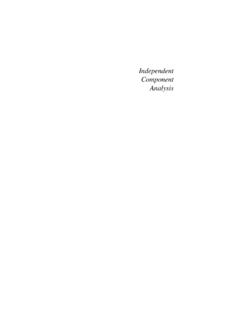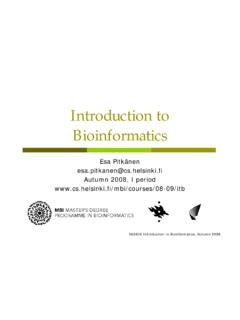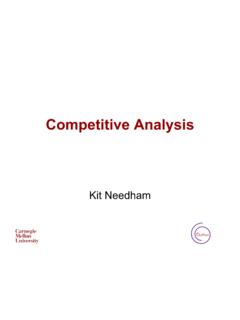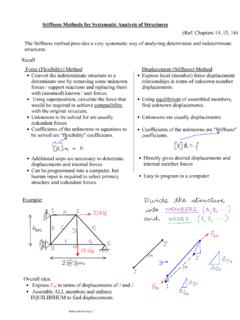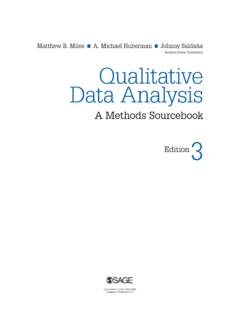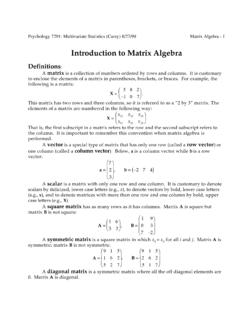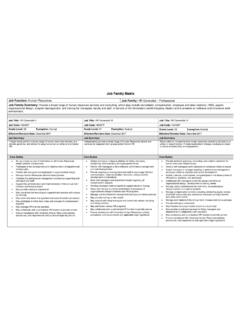Transcription of Independent Component Analysis: Algorithms and Applications
1 Independent Component analysis : Algorithms and ApplicationsAapo Hyv rinen and Erkki OjaNeural Networks Research CentreHelsinki University of Box 5400, FIN-02015 HUT, FinlandNeural Networks, 13(4-5):411-430, 2000 AbstractA fundamental problem in neural network research, as well asin many other disciplines, is finding a suitablerepresentation of multivariate data, random reasons of computational and conceptual simplicity,the representation is often sought as a linear transformation of the original data. In other words, each componentof the representation is a linear combination of the original variables. Well-known linear transformation methodsinclude principal Component analysis , factor analysis , and projection pursuit. Independent Component analysis (ICA) is a recently developed method in which the goal is to find a linear representation of nongaussian data sothat the components are statistically Independent , or as Independent as possible.
2 Such a representation seems tocapture the essential structure of the data in many Applications , including feature extraction and signal this paper, we present the basic theory and Applications of ICA, and our recent work on the : Independent Component analysis , projection pursuit, blind signal separation, source separation, factoranalysis, representation1 MotivationImagine that you are in a room where two people are speaking simultaneously. You have two microphones, whichyou hold in different locations. The microphones give you two recorded time signals, which we could denote byx1(t)andx2(t), withx1andx2the amplitudes, andtthe time index. Each of these recorded signals is a weightedsum of the speech signals emitted by the two speakers, which we denote bys1(t)ands2(t). We could express thisas a linear equation:x1(t) =a11s1+a12s2(1)x2(t) =a21s1+a22s2(2)wherea11,a12,a21, anda22are some parameters that depend on the distances of the microphones from the would be very useful if you could now estimate the two original speech signalss1(t)ands2(t), using only therecorded signalsx1(t)andx2(t).
3 This is called thecocktail-party problem. For the time being, we omit any timedelays or other extra factors from our simplified mixing an illustration, consider the waveforms in Fig. 1 and These are, of course, not realistic speech signals,but suffice for this illustration. The original speech signals could look something like those in Fig. 1 and the mixedsignals could look like those in Fig. 2. The problem is to recover the data in Fig. 1 using only the data in Fig. , if we knew the parametersai j, we could solve the linear equation in (1) by classical methods. Thepoint is, however, that if you don t know theai j, the problem is considerably more approach to solving this problem would be to use some information on the statistical properties of thesignalssi(t)to estimate theaii. Actually, and perhaps surprisingly, it turns out that it isenough to assume thats1(t)ands2(t), at each time instantt, arestatistically Independent .
4 This is not an unrealistic assumption in many cases,1and it need not be exactly true in practice. The recently developed technique of Independent Component analysis ,or ICA, can be used to estimate theai jbased on the information of their independence, which allows us to separatethe two original source signalss1(t)ands2(t)from their mixturesx1(t)andx2(t). Fig. 3 gives the two signalsestimated by the ICA method. As can be seen, these are very close to the original source signals (their signs arereversed, but this has no significance.) Independent Component analysis was originally developed to deal with problems that are closely related to thecocktail-party problem. Since the recent increase of interest in ICA, it has become clear that this principle has alot of other interesting Applications as , for example, electrical recordings of brain activity as given by an electroencephalogram (EEG). TheEEG data consists of recordings of electrical potentials inmany different locations on the scalp.
5 These potentialsare presumably generated by mixing some underlying components of brain activity. This situation is quite similarto the cocktail-party problem: we would like to find the original components of brain activity, but we can onlyobserve mixtures of the components. ICA can reveal interesting information on brain activity by giving access toits Independent , very different application of ICA is on feature extraction. A fundamental problem in digital signalprocessing is to find suitable representations for image, audio or other kind of data for tasks like compression anddenoising. Data representations are often based on (discrete) linear transformations. Standard linear transforma-tions widely used in image processing are the Fourier, Haar,cosine transforms etc. Each of them has its ownfavorable properties (Gonzales and Wintz, 1987).It would be most useful to estimate the linear transformation from the data itself, in which case the transformcould be ideally adapted to the kind of data that is being processed.
6 Figure 4 shows the basis functions obtained byICA from patches of natural images. Each image window in the set of training images would be a superpositionof these windows so that the coefficient in the superpositionare Independent . Feature extraction by ICA will beexplained in more detail later of the Applications described above can actually be formulated in a unified mathematical framework, thatof ICA. This is a very general-purpose method of signal processing and data this review, we cover the definition and underlying principles of ICA in Sections 2 and 3. Then, startingfrom Section 4, the ICA problem is solved on the basis of minimizing or maximizing certain conrast functions;this transforms the ICA problem to a numerical optimizationproblem. Many contrast functions are given andthe relations between them are clarified. Section 5 covers a useful preprocessing that greatly helps solving theICA problem, and Section 6 reviews one of the most efficient practical learning rules for solving the problem, theFastICA algorithm.
7 Then, in Section 7, typical Applications of ICA are covered: removing artefacts from brainsignal recordings, finding hidden factors in financial time series, and reducing noise in natural images. Section 8concludes the Independent Component Definition of ICATo rigorously define ICA (Jutten and H rault, 1991; Comon, 1994), we can use a statistical latent variables model. Assume that we observenlinear mixturesx1, ..,xnofnindependent componentsxj=aj1s1+aj2s2+..+ajnsn,for allj.(3)We have now dropped the time indext; in the ICA model, we assume that each mixturexjas well as eachindependent componentskis a random variable, instead of a proper time signal. The observed valuesxj(t), ,the microphone signals in the cocktail party problem, are then a sample of this random variable. Without loss ofgenerality, we can assume that both the mixture variables and the Independent components have zero mean: If thisis not true, then the observable variablesxican always be centered by subtracting the sample mean, whichmakesthe model is convenient to use vector- matrix notation instead of the sums like in the previous equation.
8 Let us denote byxthe random vector whose elements are the mixturesx1, ..,xn, and likewise bysthe random vector with elements2s1, ..,sn. Let us denote byAthe matrix with elementsai j. Generally, bold lower case letters indicate vectors andbold upper-case letters denote matrices. All vectors are understood as column vectors; thusxT, or the transpose ofx, is a row vector. Using this vector- matrix notation, the above mixing model is written asx=As.(4)Sometimes we need the columns of matrixA; denoting them byajthe model can also be written asx=n i=1aisi.(5)The statistical model in Eq. 4 is called Independent Component analysis , or ICA model. The ICA model is agenerative model, which means that it describes how the observed data are generated by a process of mixing thecomponentssi. The Independent components are latent variables, meaningthat they cannot be directly the mixing matrix is assumed to be unknown. All we observe is the random vectorx, and we must estimatebothAandsusing it.
9 This must be done under as general assumptions as starting point for ICA is the very simple assumption thatthe componentssiare independence will be rigorously defined in Section 3. It will be seen below that we must also assume thatthe Independent Component must havenongaussiandistributions. However, in the basic model we donotassumethese distributions known (if they are known, the problem isconsiderably simplified.) For simplicity, we are alsoassuming that the unknown mixing matrix is square, but this assumption can be sometimes relaxed, as explainedin Section Then, after estimating the matrixA, we can compute its inverse, sayW, and obtain the independentcomponent simply by:s=Wx.(6)ICA is very closely related to the method calledblind source separation(BSS) or blind signal separation. A source means here an original signal, Independent Component , like the speaker in a cocktail party problem. Blind means that we no very little, if anything, on the mixing matrix , and make little assumptions on the sourcesignals.
10 ICA is one method, perhaps the most widely used, forperforming blind source many Applications , it would be more realistic to assume that there is some noise in the measurements ( (Hyv rinen, 1998a; Hyv rinen, 1999c)), which would mean adding a noise term in the model. For simplicity,we omit any noise terms, since the estimation of the noise-free model is difficult enough in itself, and seems to besufficient for many Ambiguities of ICAIn the ICA model in Eq. (4), it is easy to see that the followingambiguities will hold:1. We cannot determine the variances (energies) of the Independent reason is that, bothsandAbeing unknown, any scalar multiplier in one of the sourcessicould alwaysbe cancelled by dividing the corresponding columnaiofAby the same scalar; see eq. (5). As a consequence,we may quite as well fix the magnitudes of the Independent components; as they are random variables, the mostnatural way to do this is to assume that each has unit variance:E{s2i}=1.
